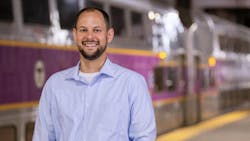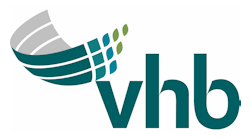One word to describe yourself: Easygoing
Alma Mater: Northeastern University (Massachusetts)
Fun fact about yourself: I love travelling and hiking with my wife, Taylor, and am excited to now share those experiences with our one-year-old daughter, Maeve.
Favorite station or stop that you have ever visited or frequent (and why): Grand Central Terminal, New York City – Nostalgia. I travelled through it often having lived upstate growing up and I love the main concourse and the whisper gallery.
Favorite route you have ever ridden or frequent (and why): The MBTA Green Line – I lived on and frequently rode this line in college at Northeastern, and I love its history, starting as the first subway in America.
Josh Bendyk is a leader in rail and transit operations assessment, rail operations planning and railroad engineering, executing integrated and multi-disciplinary projects. During his 12 years with VHB, Bendyk’s integrity for quality work, optimism and deep respect for his clients’ vision has been instrumental in helping to grow VHB’s transit and rail practice. Bendyk’s approach is to view challenges as opportunities to deliver innovative solutions. He supports the development and expansion of the Transit & Rail Operations Group and continually shares his service planning, train simulation and signal block and aspect design skills with his team.
He routinely partners with rail and transit agencies such as New Jersey Transit, Metro-North Railroad, Amtrak, Massachusetts Bay Transportation Authority (MBTA) and Massachusetts Department of Transportation (MassDOT) to model some of the most complex projects along the East Coast, including the South Station Expansion in Boston, Penn Station Access in New York and the Long Bridge Project in Washington, D.C.
Bendyk is an operations leader who has been cross-trained in signal engineering with extensive knowledge in signal aspects and speed commands, control lines and safe braking and capacity calculations. Recent projects he has been involved with include:
- MassDOT/MBTA South Coast Rail Phase 1 Final Design Project to improve public transportation between Boston and New Bedford/Fall River. Bendyk led the final design of the signal blocks and control lines across 38 miles, the analysis to develop the new service operating plan and verified the suitability of existing and proposed infrastructure to support the new service extension.
- MBTA Red Line and Orange Line Signal Systems Upgrades Design Build Project to renew the Red and Orange Line track circuits, relay control logic and associated control room equipment. Bendyk is leading the design of revised signal blocks and control lines that incorporate new speed commands, performing signal block and control line design, safe braking calculations, capacity calculations and full simulation modeling of the existing and proposed systems.
Bendyk has grown a team of operations analysts, engineers and planners that have a real world understanding when developing and interpreting operations models and railroad capacity. Bendyk has shared his experience with railroad signal design, signal block layouts and aspect design and safe braking analyses, and his team’s combined knowledge of railroad operations and signals allows them to not only identify operational issues or challenges through the operations simulation models, but to also solve those issues.
In 2015, Bendyk was recognized with the VHB Innovation Award for his use of rail simulation modeling software to analyze unique and complex infrastructure environments and take the outputs from the software and convert the highly complicated technical information into easy-to-understand graphs and charts. As a result, Bendyk and his team have much more meaningful meetings and discussions with clients and stakeholders who are able to easily understand the complex operations being represented and provide valuable input and feedback.
Bendyk belongs and contributes to many industry organizations including the American Railway Engineering and Maintenance-of-Way Association (AREMA), Transportation Research Board (TRB) and New England Railroad Club.
Is there a specific experience that led you to where you are today?
There hasn’t been a specific experience, but there have been specific people. If there was one person who inspired me to be an engineer, it would be my dad. His ability to do anything from writing code as an engineer for IBM, to building a house, to rebuilding an engine, to being a soccer coach (having never played), he always amazed me. He taught me, through example, that you can do anything if you put in the effort to learn and work hard to succeed. I carried that with me in school, every day throughout my career and as a homeowner and now a new father, as well.
Another influential person in my career would be my manager, Terry Byrne. Terry was my boss from my first Northeastern co-op at VHB 16 years ago and inspired me to take an interest in railroad operations and signals, a topic not covered in my transportation classes. The daily challenges and seemingly infinite new problems to solve really attracted me to this niche in the transportation engineering industry. I ended up leading our firm’s team for this niche that didn’t exist when I started, and I have Terry to thank for all of that and more.
What do you enjoy most about your job?
I get excited to go into work because a primary component involves problem solving on a daily basis. I enjoy and excel at puzzles and railroad operations and signaling are full of real-world puzzles and logic problems. Figuring out the when, where and how to schedule and route trains to get maximum efficiency, or to develop proposed operating plans or signal infrastructure – it all boils down to logistical puzzles and problem solving. No railroad operation or signal layout is the same, which keeps me challenged with new problems on every project.
What’s the most challenging part of your job?
Converting highly complicated technical information into relatable metrics, graphs and charts to clearly demonstrate operational challenges or deficiencies in an operating plan or from a given infrastructure. Doing so allows us to have much more meaningful meetings and discussions with clients and stakeholders who can easily understand the complex operations being represented and provide valuable input and feedback.
Accomplishment you’re most proud of and why?
Helping to build and lead our firm’s rail operations group from two members to a successful team of eight, while also becoming trusted advisors to our clients. It’s extremely rewarding to look back to where we started, and where we are now with the incredibly talented team we’ve built, the projects we’ve worked on and the clients who we’ve provided solutions to and built relationships with.
Best advice/tip/best practice to share from your area of expertise?
Seek out mentors and develop trusted relationships. I have been very fortunate to have several excellent mentors so far in my career and those relationships are invaluable.




